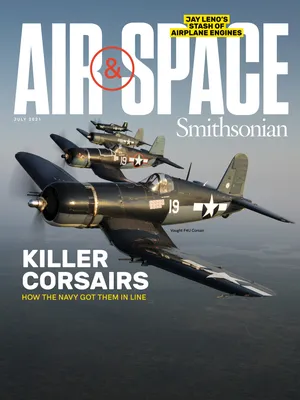Across the Channel in a Nazi Helicopter
Hans-Helmut Gerstenhauer earned a place in history. He would have settled for a job.
/https://tf-cmsv2-smithsonianmag-media.s3.amazonaws.com/filer/06/87/0687585f-71a3-4d8f-b29e-9f9f8818b24c/04g_jj2021_gerstenhauermechanicsviahubschraubermuseumbuckeburg_live.jpg)
A cold wind cuts across the boggy heathland of the New Forest on the southern coast of England. Wild ponies drink from the puddles that the heavy rain has left behind. At first there appears to be nothing left of RAF Beaulieu and the Airborne Forces Experimental Establishment (AFEE) that covered the heath in concrete. The British Parachute Regiment was established in 1942, and the AFEE was the unit tasked with researching and testing parachutes and the aircraft that would carry the jumpers—gliders, and beginning in 1945, helicopters.
From the air, the ghostly A-shape outline of the crisscrossing runways can still be seen, but on the ground, traces are hard to find. The GPS on my phone tells me that I am standing where the runway should be, but all I can see at my feet is a thin covering of bracken and a layer of mud mixed with what looks like gravel but may be the rubble of blitzed cities like nearby Southampton.
Further on, I find a large expanse of concrete where the hangar for B Flight and their primitive helicopters once stood. Igor Sikorsky had manufactured 131 of his two-person R-4 helicopters, and by September 1945, a handful of the machines had made it to the AFEE for evaluation.
/https://tf-cmsv2-smithsonianmag-media.s3.amazonaws.com/filer/fd/17/fd170784-9113-498d-b930-65cf018fd3f5/04b_jj2021_11356305_live.jpg)
While the first, flimsy-looking auto-gyro crossed the Channel in 1928, I am standing where, on September 6, 1945, Hans-Helmut Gerstenhauer, now working for the Allies, landed the first helicopter to cross the English Channel. The large, two-rotor helicopter bore the white star of the United States Army Air Forces (USAAF) on the fuselage, but if a mechanic had scraped away the paint, he would have found the black cross of Nazi Germany underneath. For the charismatic 30-year-old, this was the culmination of a personal odyssey to secure a future for himself and his machine, which had begun in the last days of the Third Reich.
The helicopter was the Focke-Achgelis Fa 223 Dragon, the brainchild of Henrich Focke, co-founder of the Focke-Wulf company and widely regarded as the designer of the world’s first practical helicopter. The Dragon looked nothing like its single-rotor American rival. Its two huge counter-rotating rotors positioned on either side of the long rectangular fuselage, and its airplane-like T-shape tail, made it look like a modern-day tiltrotor. Whereas the American helicopter just managed to carry a casualty litter, the German machine could lift a 1,600-pound Volkswagen Kübelwagen.
On October 3, 1945, Gerstenhauer took off from roughly this spot in his Dragon for a short demonstration flight, only two flying hours after his historic Channel crossing. His helicopter rose to 60 feet and then plummeted to the ground. He escaped grievous injury, but the last of the 37 Dragons built was no more.
In the postwar chaos, Gerstenhauer’s cross‑ Channel achievement went largely unnoticed.
“Like the first airplane to cross the Channel in 1909, or the first electric airplane in 2015, the flight was a big deal,” says Mike Hirschberg, executive director of the Vertical Flight Society. “It deserves wider recognition.” Hirschberg has worked in the aerospace industry for 30 years, including more than 10 as an adviser to the U.S. government on advanced aircraft and rotorcraft concepts.
Erasmo Piñero Jr., principal engineer at Bell Flight and a former U.S. Navy aviator, has some idea of why Gerstenhauer’s historic Channel crossing has become obscure. “The war had just ended, and the last thing people wanted to be bothered with was weapons of war,” he says. “But the flight has a huge significance for engineers like us who understand the technology.”
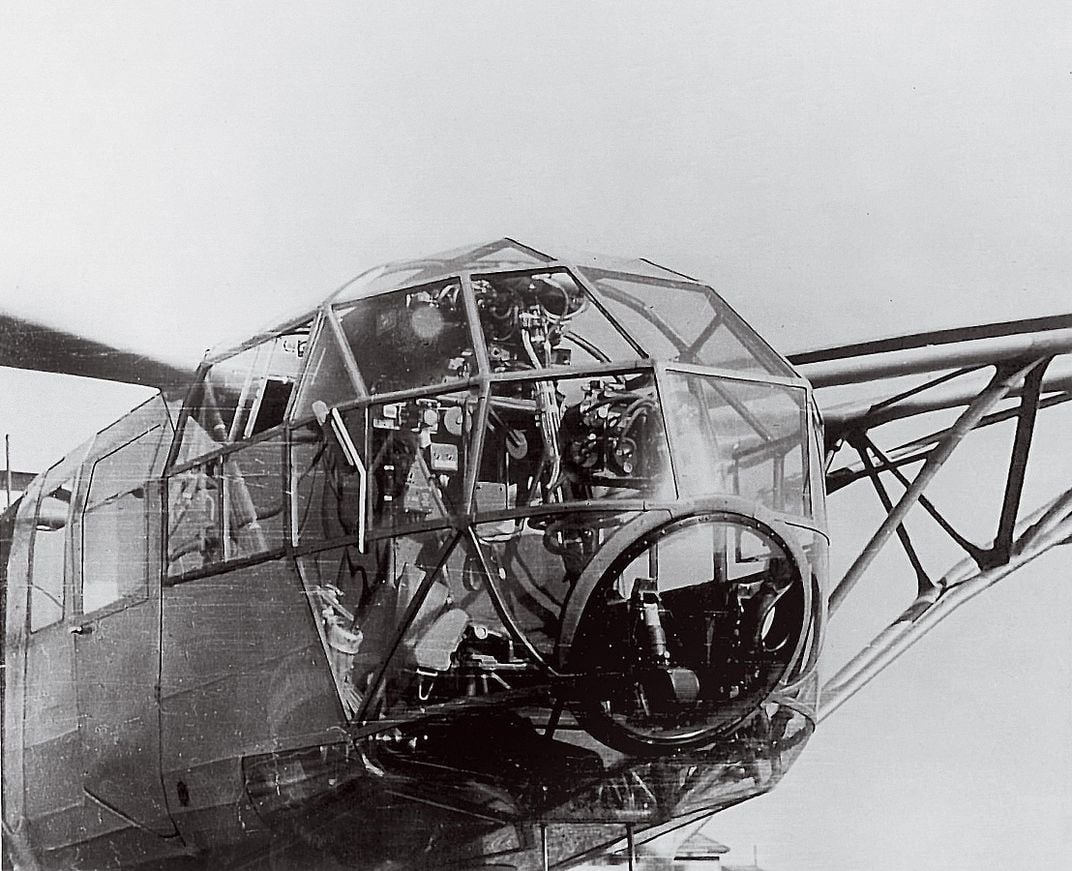
A Forgotten Pioneer
Today, Hans-Helmut Gerstenhauer is largely unremembered outside Germany. Even his archive, at the Bückeburg Helicopter Museum in his home state of Lower Saxony, is obscure.
Born in 1915 in Diepholz, Gerstenhauer began his training as an aeronautical engineer when he was 18. While mastering the slide rule, he also learned to fly a glider. “I am flying!” he scrawled under a photograph that caught the moment. In 1935 Gerstenhauer graduated as an engineer, but he yearned to be in the cockpit, not behind a desk. Two years later, the Luftwaffe conscripted him.
Gerstenhauer followed the Panzers across Europe, flying reconnaissance missions from Cherbourg on the French coast to Novgorod and Smolensk in Russia. Fighter Training School in 1942 led him not to glory but to ferrying Ju-87 Stukas around on non-combat missions.
In August 1942, Gerstenhauer was offered a job as a test pilot at the helicopter company Focke-Achgelis. The letter of employment from Henrich Focke ended with “Heil Hitler!”
A few events from his tenure stand out. In 1943 he flew the Fa 330 Wagtail in Europe’s largest wind tunnel, the 60-foot-wide tube at Chalais Meydon in occupied France. The Wagtail was a single-seat gyro-kite that resembled an armchair with three rotors above it, designed to be towed behind a U-boat. The following year, Gerstenhauer’s Dragon crashed during an attempt to lift the propellers and fuel tank from a crashed Dornier. A week later he was back in another Dragon to recover both aircraft.
In March 1945, Gerstenhauer rescued the pilot of a Messerschmitt Bf 109 that had crashed in a snowstorm. Later that month, he completed what Helicopters of the Third Reich author Steve Coates maintains was “the longest single flight of any helicopter at that time,” covering the 199 miles from Gotenhafen (Danzig), as the city was falling to the Soviets, to Swinemünde. He flew at a height of just 33 feet, in abysmal weather, to avoid the notice of Soviet fighters.
For the world, the Age of the Helicopter began in Bremen, Germany, on October 18, 1937, when a newsreel cameraman captured Charles Lindbergh looking up at Henrich Focke’s record-setting helicopter hovering above him. The Fw 61 that caught Lindbergh’s attention looked as though a huge rotor had simply been attached to either side of a World War I monoplane. The Dragon took this configuration one step further. Hitler took one look at it and said: “That could be very useful for mountain warfare.”
“Certainly, what’s happening in the late 1930s in Germany is probably the most interesting thing going in terms of helicopters,” says Roger Connor, curator of the National Air and Space Museum’s vertical lift collection. “The German role is this inspiration moment when the world realizes that the technology is becoming practical, and Sikorsky was very adept at playing this to his advantage.”
The reputation of German designers like Focke was such that in May 1940 American newspapers reported rumors that the German paratroopers who had captured the seemingly impregnable Fort Eben-Emael in Belgium had landed by helicopter. (In truth, the siege of Fort Eben-Emael had been the first use of gliders in wartime.) Sikorsky made this a sales pitch, calling helicopters the “vehicle for tomorrow’s parachute armies.” That same month as the Germans captured Eben-Emael, the U.S. Army Air Corps chose the Platt-LePage Aircraft Company to build its first helicopter because it offered the closest thing to Focke’s design. Platt-LePage’s triumph was short-lived; Sikorsky eventually won out in trials of its R-4, also besting the records set by Focke’s machine.
“In the U.S., there was something of a helicopter craze in 1943,” Connor says. “They featured prominently in newsreels, comic strips, and Life magazine. There was even a suggestion that personal helicopters would become commonplace after the war.”
/https://tf-cmsv2-smithsonianmag-media.s3.amazonaws.com/filer/46/77/4677f801-827a-4c6b-b1c2-63450e19f125/04a_jj2021_11356304crop.jpg)
Defects and Defectors
Tuesday, May 8, 1945 was a sunny spring day in the Austrian Alps and the war seemed far away. Gerstenhauer had gathered a rogue squadron—his Dragon and two mechanics, Fritz Will and Heinz Zelewski, and two more helicopters and their pilots. The small band somehow squeezed itself into an orchard outside the village of Pongau, which clung precariously to the sides of a narrow mountain gorge.
Germany’s surrender presented Gerstenhauer and the other men with a dilemma: “We must decide ‘to march home on foot’ or ‘fly on as long as we can,’ ” he wrote in his diary. There was of course a third option: Turn their aircraft over to the Americans. Operation Lusty (Luftwaffe Secret Technology) was the USAAF’s effort to scour the Reich for its advanced technology and ship it back to the United States, along with, more controversially, many of those who had designed it.
Fellow Fa 223 pilot Carl Bode says he passed an order to Gerstenhauer to destroy his helicopter rather than let it fall into Allied hands. If Gerstenhauer got this message, he ignored it. The next day, he and his companions flew almost at ground level along the slopes of the Salzach Valley to an airfield at Ainring, roughly 40 miles away, to surrender to the Americans.
The Americans wanted Gerstenhauer and the rest of his squadron to fly their helicopters to Querqueville Airfield near Cherbourg, from where they would be shipped to the States.
“Will this be the starting point of pastures new for us?” wondered Gerstenhauer after he had flown to Querqueville with the two other German helicopters on June 16. The answer seemed to be no, as he and his companions were ordered the next day to fly back to Frankfurt. “I ask myself why we have had to creep hither and thither for 430 miles to discover this…but obviously U.S. bureaucracy is no better than ours,” he griped in his diary.
Gerstenhauer’s disappointment was palpable when they left Cherbourg on June 20. “We three start our return flight having buried our hopes of the promised land,” he wrote. But the men never made it back to Germany.
At the airport at Villacoublay, Paris, French police arrested Gerstenhauer and his mechanics and took them to nearby Limoges, where they were held under guard with other high-value German experts for six weeks. Visiting bigwigs who wanted a demonstration of the “big Focke” would occasionally relieve the boredom of their confinement. These visitors included Lawrence Bell, president of the Bell Aircraft Corporation, who plied the German prisoners with questions. “I get the impression that they have not reached our stage of helicopter development in the USA but are determined to catch up,” Gerstenhauer noted.
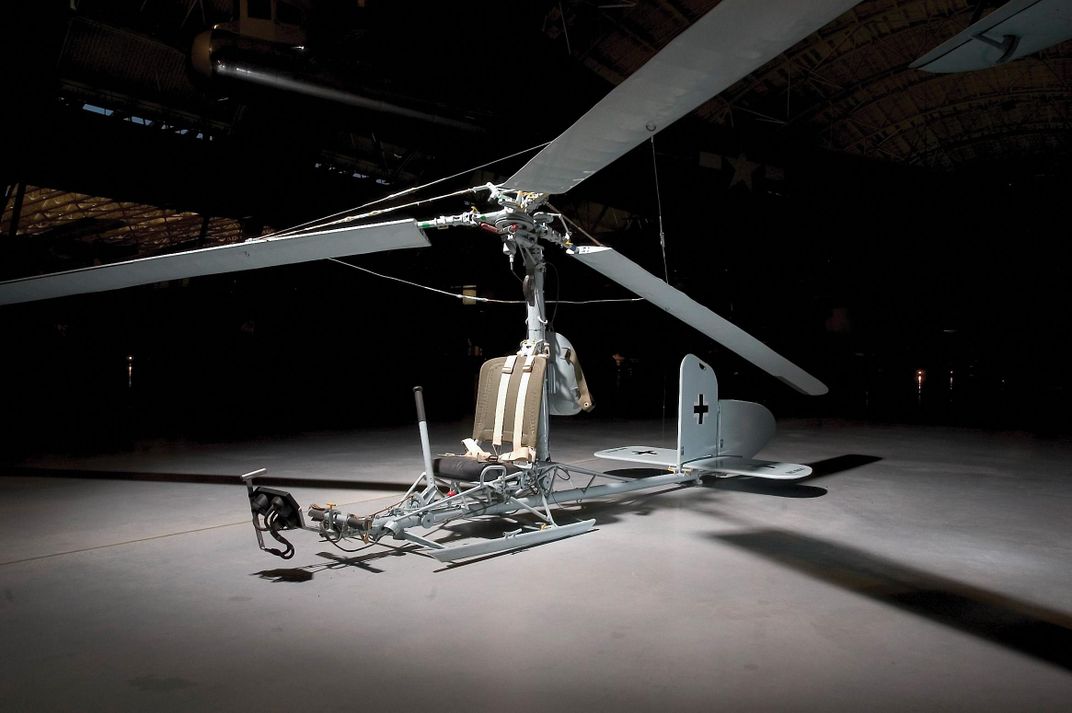
Eventually, Gerstenhauer and his men were told that the Allies wanted them not in America, but in England. On September 4, 1945, he started his flight in the Dragon with Flight Lieutenant Morris. The two mechanics, Will and Zelewski, would fly with Squadron Leader Strong in an Avro Anson.
Rain and high winds prevented the Channel flight that day and the next. When the weather cleared, a stiff wind from the north led the British officers to decide to cross the Channel at its narrowest, the Strait of Dover. With no refueling points on the French other side, Gerstenhauer and his crew lashed 22 gallons of kerosene to their undercarriage struts to refuel at Abbeville before attempting to cross.
In the strong wind, the Dragon crawled along the coast and eventually reached Abbeville, but their chase airplane had flown on. After one last cigarette at 5:10 p.m., they started “against England.”
Gerstenhauer flew hair-raisingly low, above “the heads of fishermen in their boats who look at us in astonishment. I fly fairly low because I can make better progress with the ground effect.”
As England’s white cliffs neared, he was disoriented. “I am no longer certain if we are on course,” he wrote. “Is that cliff to the left ahead of me Dungeness Point or South Portland, north of Dover?”
Climbing to 980 feet, he realized that he was on course and relaxed. “I close the throttle and sail in an elegant curve over and beyond the harbor jetty, and from the beach, people wave up a ‘welcome.’ ”
To Gerstenhauer, Lympne air base looked more like a golf course than an airfield, but this backwater’s sleepy atmosphere hid a more eventful past. Its location in the south of England, so close to France, meant that it had been attacked by both the Imperial German Air Force in World War I and the Luftwaffe in World War II, as well as by Hitler’s V-1 weapons. It was also one of the first airfields with a customs post in the United Kingdom.
Customs was closed when they landed. “We land in front of the control tower and are waved into our parking place by a lonely soldier and given a welcoming cup of tea. That’s it—that’s how the Focke [became] the first helicopter to fly across the Channel between the continent of Europe and England.”
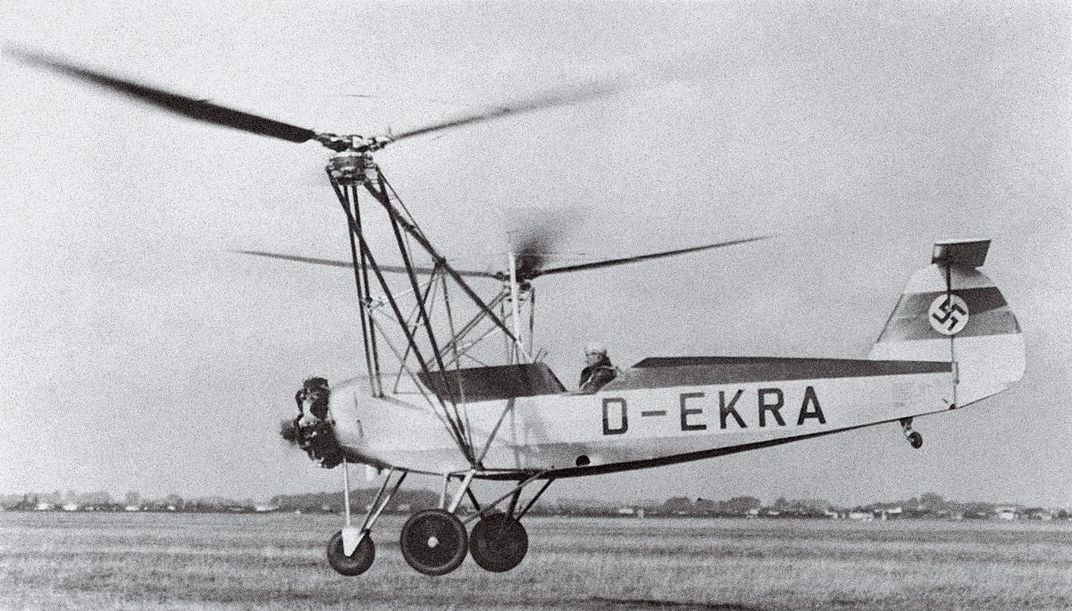
Finally, they set off on their last leg to RAF Beaulieu, where they were first greeted by the commander and then the immigration authorities, who wanted to know how three German civilians had entered the country without passports or visas.
The next day, Gerstenhauer saw an American helicopter for the first time, shaking his belief in Germany’s technological superiority. “This two-seater type is, however, much smaller…and has only one central lifting rotor and one tail rotor,” he wrote. “The control system is much simpler than that of the Fa 223. Added to that the maneuverability is much better.” On September 8, he saw the Sikorsky fly, recording that “with its maneuverability and climbing capabilities, [it] makes a good impression. So the Americans will have soon caught us up and then, after a victorious war, all the means and capacity for production will stand at their disposal whilst we are only allowed to cultivate our cabbages.”
A few days later he saw the next generation Sikorsky machine, the R6-A, and acknowledged Germany’s designers and engineers had been bested. “One recognizes that the Americans have made progress and are probably leading the world,” he reflected to his diary that evening.
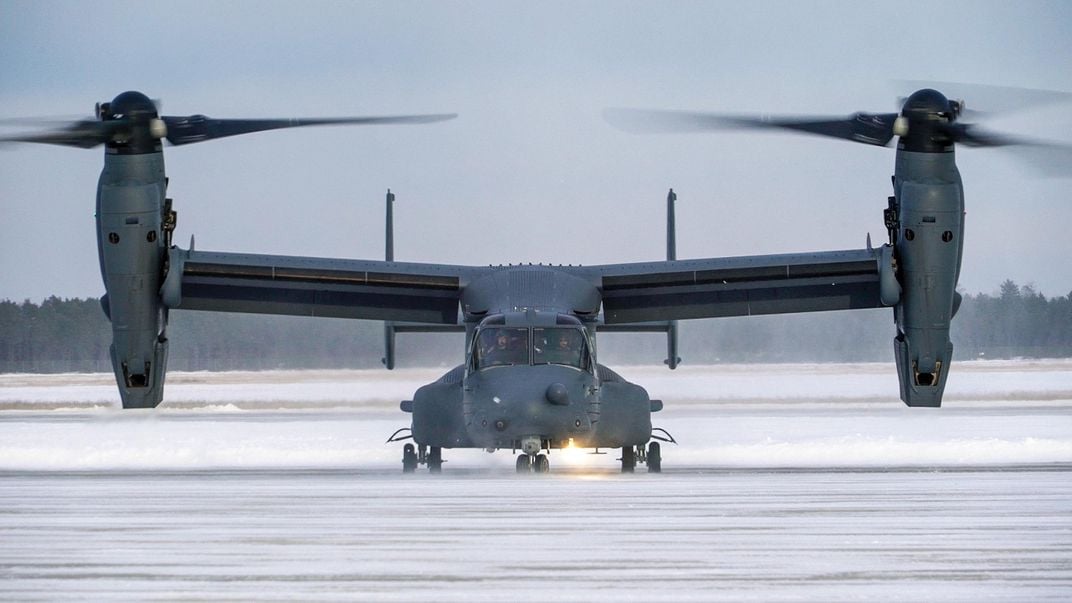
All That Remains
Today, Midland Air Museum sits at the edge of Coventry Airport. An Avro Vulcan bomber towers over the museum’s parking lot. Logistics centers and office blocks creep closer to its perimeter each year. I have come to see a unique aircraft, one that explores the border between a restored aircraft and a replica. This Flettner Fl 282 “Hummingbird” is very likely the world’s last surviving Nazi helicopter. It’s also the closest relative of the Fa 223 that I can still examine “in the “flesh.”
The frame, rotor heads, and wheels are nearly all that remains of the original aircraft. The joystick somehow eluded the souvenir hunters, though it is now too valuable to display. Permitted to hold it, I find it surprisingly heavy.
There were attempts to use the German technology in the United States, Britain, France, and Czechoslovakia. The French built their own short-lived version of the Dragon; the Czechs assembled a handful of Fa 223s from parts they had found.
“There were four configurations that the Germans helped to pioneer: there were the side-by-side rotors, the coaxial rotors, the inter-meshing rotors, and jet rotors,” says Erasmo Piñero. “This is a big chunk of helicopter history.”
Heavy-lift K-MAX helicopters, which rely on the intermeshing rotors concept Anton Flettner pioneered in the Fl 282 80 years earlier,were used by the U.S. Marine Corps in Afghanistan and are now being transformed into autonomous aircraft for the Marines.
“The Piasecki tandem rotor concept is close to Focke’s side-by-side,” says Berend Gerdes van der Wall, senior scientist at the German Aerospace Center. “And this finally came to a successful product line in today’s CH-47, which is considered to be a heavy transport helicopter.”
Piñero points out that Focke’s side-by-side rotor configuration led to the contemporary V-22. “We’re back where we started. The first practical helicopter was the Fw 61,” he says, naming the seminal 1936 twin-rotor aircraft. “And the way to fly in the future will be the tiltrotor that can fly like a plane or a helicopter.”
Although the twin rotors of Focke’s Fw 61 reappear in the V-22 Osprey, the majority of postwar helicopters followed the designs of American pioneers Sikorsky and Bell.
“The Mil Mi-26 Halo, which is the biggest and most powerful helicopter in the world, is really just a hyper-inflated Sikorsky R-4,” says Ron Smith, former head of future projects at Westland Helicopters.
Gerstenhauer predicted the dominance of Sikorsky’s designs and knew that Bell would continue the advances in rotary flight. In January 1948 he wrote to Bell, asking if there were opportunities in the States for him. Nothing came of it.
With a recommendation from Focke, Gerstenhauer did find work in the car industry and then on the F-104 Starfighter program, and in vertical flight on Germany’s experimental VJ-101 tilt-jet fighter aircraft program. The ambition of the supersonic VTOL fighter was a homage to German engineers like Focke.
On March 26, 1946, the day before he left to return to Germany, Gerstenhauer made one last flight. This time, he was flying an R-4 Sikorsky helicopter.
Mark Piesing is a journalist and event moderator based in Oxford, England. His nonfiction book N-4 Down: The Search for the Arctic Airship Italia—the true story of the largest polar rescue mission in history, searching for survivors of the luxurious airship that crashed near the North Pole in 1928—will be published in August 2021.
